The people of Vishnoi
In India still exist alot of native folks which live far from the cities and live exclusively from agriculture. In this regions old traditions and rituals are still very important in the everyday life and school education is not very common (around 40% of the Indian population is illitareted).A folk which impressed me very much was the people of Vishnoi. They live near Jodphur in the desert of Rajasthan. A Chilean and I (who thought I can practice my spanish in the desert of India?) took a guide and started to the dusty trip. Both of use were very happy to get out of the traffic and pollution of Jodphur. By the exit of the town we saw now and then a few camels with a cart...
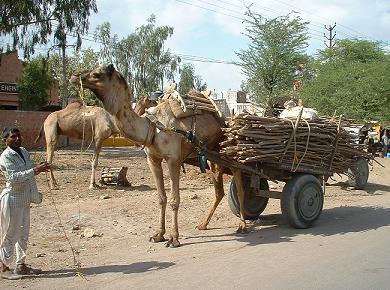
...further out of the town we saw just bicycles, tractors and from time to time a bajaj -the Indian Vespa...
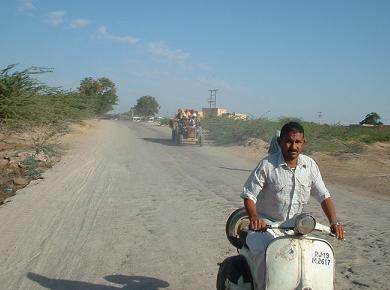
...then the street became totally empty and we couldn't see anybody! How nice this abrupt silence was!

In India you are set out mostly a constant noise level. The majority of the Indians live in the cities together on a very small space and produce alot of noise, pollution and garbage.
So you're never alone -except when you're sleeping or on the toilet ;-)
According to this it's very nice to be alone for a while
and to enjoy the silence!
After around one hour we arrived the village of the Vishnoi -well to call it village is exaggerated but you find a few houses under some trees over a couple of kilometres wild distributed in the desert.
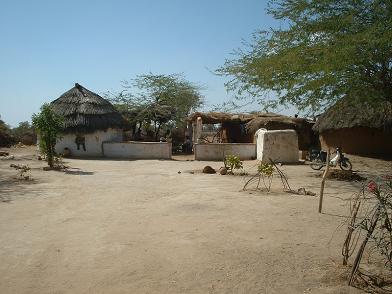
When we arrived we were saluted friendly. The Vishnoi women wear a massive golden nose ring on which is fixed a chain which reachs to the ear ring.
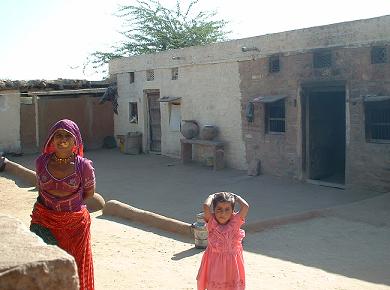
The Vishnoi have their own religion: for them the animals and the trees are holy! So they eat no meat which isn't that special but they don't cut down the trees because of their holiness. So by the construction of the buildings no wood is used and the fire for cooking is made of bush branches and cow dung which are dried in the sun before and are mounted up to crowds.
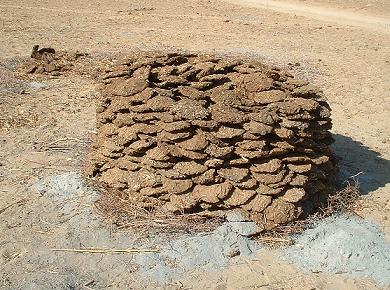
Around 300 years ago the maharaja of Jodphur ordered to cut the trees in this region for the construction of buildings. The Vishnoi didn't want to watch defenceless how the workers cut the holy trees and huged the trunks as living shields. 363 Vishnois were massacred by the tree cuters until the Maharaja heart about the "incident". Then he enacted a law which forbids tree cuting in the region of the Vishnois. After that the Vishnois built a monument which reminds of the victims and after that they celebrate the liberty of the trees every year.
We were asked very friendly to enter the house and to visit the family and in the meantime the woman prepared a jai (spice tea).
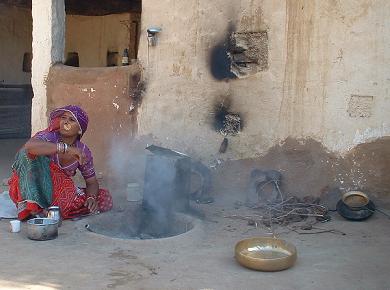
Because they entertained us so nicelly we wanted to give the family some money! But they didn't want to take it and told us that they're very happy to greet and entertain visitors. We knew that not alot of tourists find the way out here but we didn't except that they didn't want to take money for giving us jai. Because we knew that in India nobody offers you something for free or without any ulterior motives (at least in the places where tourists go or you could say where locals are used to tourist). But finally we could leave something there -it's not that they wouldn't need it!
On my trip I had a lot of similar experience and my opinion is:
The less people have the more they share! Poor people are in many points much more social than we are even though we think our country is very social and we call Switzerland very often a "social state". This means that we put old and handicapped people in homes. Of course this can be called social but for this reason we lose the social qualities from one to the other.
People in poor countries don't have health insurance and assurance and all this things. Their only security are their children or the family. So this people are reliant on their fellow man -and you can feel it- they really know that and act like this. And this is always a thing which makes me astonishing
-we could really learn something from thhis people!
After the visit by the Vishnoi we drove to another family where we had our lunch. But before we could eat we had first to try opium!
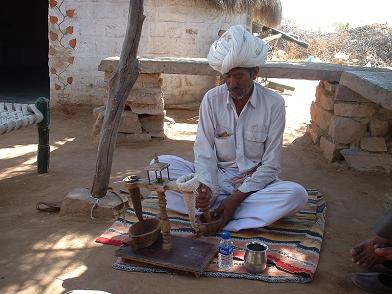
Don't panic! Opium in small quantity is not dangerous but rather it's healthy and is also used for medical purposes.
First the opium is ground with a mortar and than mixes with water. Than the water is poured through a filter so that the opium powder remains in the filter. After that you can drink the water -but never forget to give first some drops to the opium god!! After that ceremony we could drink the water. It was bitter and without any effect...of course they didn't give us a full dose. Well, at least we can say now that we tried it once ;-)
During the opium ceremony the daughter of the opium man prepared the food.

The menu was dal (lentil stock), an undefinable vegetable (similar to dried beans) and naan (a flat bread cake).
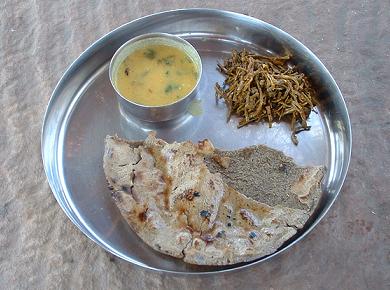
Mmmmhhh! Really good! The only problem is that this people eat this almost every day because due to the climate not many different plants are able to grow here.
I think life is very hard here in the desert because people are exposed to the heat every day and the work on the field is made totally by hand. Even though the earth here isn't very rank the water from the three months monsun brings enough water to let grow a few plants but it's necessary to collect and contain the rain water in wells. But in this way field, animals and people have enough water for the whole year. Of course the use of the water is different to our understanding of using water because often they have to transport it a few hundert meters from the wells to the houses.
The visit by the Vishnoi was very impressive because we saw how this people live and how they manage their daily life with primitive tools and without any luxury. Experience like this make me always think alot about our life style and to be honest I'm really happy and lucky to be a European.
Andy
19.03.04, Jodphur, India